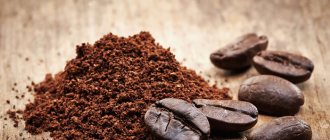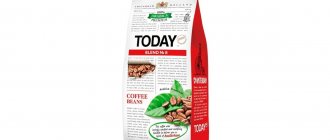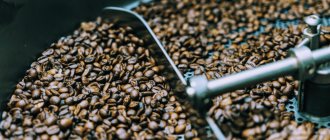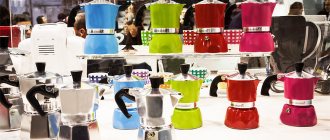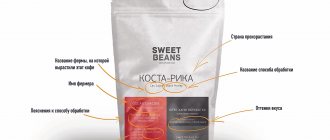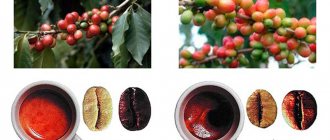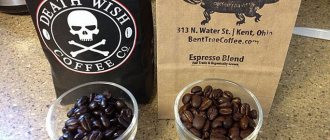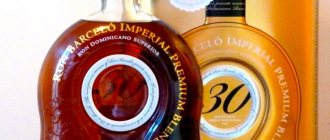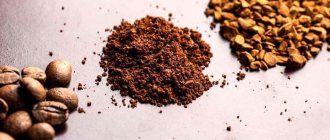History of the invigorating drink
Coffee first appeared in Finland only in the 18th century. The first cup of this drink was drunk in Vyborg. The drink, new to the Finns, was perceived by the Lutheran Church as a dangerous innovation, as a result of which it was banned. Despite this, wealthy residents of the country eventually became addicted to it: already in 1750, there were about a hundred or more fans of this drink in Helsinki. As a rule, Finnish coffee was available only to representatives of the rich segments of the population. A century later, it became one of the attributes of Finnish life. A coffee grinder and ground Finnish coffee appeared in almost every home, and the rich aroma of beans was in the air. The favorite drink was also reflected in the art of that time. Finnish coffee beans were described more than once in many literary works of that time - for example, in the story “For Matches” by Maiju Lassila, in which the main character went for matches to make Finnish coffee.
In 1876, the German Gustav Pauling founded the company of the same name. Initially, its main activity was the import of coffee beans to Finland. In 1929, the most popular brands appeared - Presedentti and Juhla. It was at this time that Finnish coffee began to be sold in the usual packs. The country of Suomi experienced an acute shortage of the invigorating drink during the Second World War. Today, a pack of coffee presented as a gift to a Finn is a sign of respect.
The history of coffee in Finland
Finn Axel Käg first experienced the aroma and taste of coffee in 1637, when he served a German prince. There are two versions where the Finn could try it. According to the first, he met him on a trip to Persia, where the German prince often visited. In the 17th century, coffee was already a traditional drink for the Persians. They drank it while listening to music and leisurely conversation. According to the second version, in Europe, where it was brought in 1615 by Venetian merchants.
Coffee came to Finland itself in the 18th century. The first who were lucky enough to try it were the residents of Vyborg. They were delighted with its taste. Soon the number of drink lovers exceeded 100 people.
The Lutheran Church and the King of Sweden prohibited the consumption of coffee. Finland was under Swedish rule from the 12th to the early 19th centuries. Lutheran priests sounded the alarm when they saw the mark of the “Black Moors” in the coffee. For the king, large volumes of imports of expensive products threatened the national currency. In 100 years, 4 bans were issued. Residents who, despite the ban, made coffee, were fined, and then all the dishes were taken away.
This did not deter wealthy families, who continued to buy smuggled coffee. Resigned, in 1801 the king lifted all restrictions. After 100 years, it became available to all segments of the population. In almost every home, the morning began with a cup of coffee prepared in Finnish style.
The Finns' fiery love for coffee is reflected in many literary works. For example, Moominmama of the Finnish writer Tuvi Janson brewed it every day. If there were any difficulties, she would say: “Everything will work out, you just need to make some coffee.” Adults and children drank it. And if suddenly it ended during the campaign, then everyone was very upset.
In 1876, the German Gustav Pauling created the first company importing coffee. He named the company after himself - Pauling. First, they imported green coffee, which the Finns roasted at home themselves. It was only at the end of the 19th century that John Arbuckle invented the industrial roasting method. In 1926, roasted coffee sales exceeded green coffee sales.
Further difficulties with coffee supplies arose only during the Second World War. Then, instead of it, they brewed chicory, and when things were really tight, they brewed dandelion roots. After the end of the war, the ship with coffee was greeted with genuine joy.
Features of the coffee ritual in Finland
Finnish coffee is not so much a tradition as an addiction and a habit. According to statistics, Finns drink more coffee than any other people in the world - about 12 large cups daily. True, their drink - kahvi - is no different in strength and is more reminiscent of an Americano. Finns do not use any additives, and if they do use them, it is extremely rare. Finnish style does not imply anything superfluous, and therefore in their coffee shops there is practically no division between latte, espresso and other types of drink.
Pikakahvi - instant coffee - is not particularly liked by Finns: they drink it extremely rarely. The drink is prepared using drip coffee makers by passing water through roasted ground coffee beans collected in a paper filter.
Separately, it is worth mentioning “Scandinavian roasting” - beans roasted in this way turn out to be a soft light brown hue, and the drink is weak and calm. Each product package sold in Finland is marked on the reverse side according to the degree of strength, that is, the degree of roasting of the beans - from 1 to 5. Buy strong Finnish ground coffee, reviews of which can be found not only on the Internet, but also in coffee shops, with a degree Roasting more than 1 or 2 beans is extremely difficult.
Coffee from Paulig
The Paulig concern is the leader in coffee production in Finland. Most popular brands belong to him.
Finnish coffee Juhla Mokka
The most famous brands of Paulig coffee and their degree of roasting (strength):
- Juhla Mokka (1) and Juhla Mokka tumma paahto (2) are ideal for evening gatherings with friends;
- Presidentti (1) and Paulig Presidentti tumma paahto (3) for preparing a “celebratory” drink with a mild taste;
- Brazil (2) from the Brazilian variety of santos beans;
- Presidentti Black Label (4) with a chocolate aftertaste thanks to Kenyan Arabica;
- Presidentti Gold Label (4) premium blend of Arabica beans from Ethiopia and Papua New Guinea;
- Parisien Coffee (5) made from robusta beans, usually drunk with milk.
In addition to the listed brands, the Paulig line includes Arabica, Espresso, and Mokka coffee blends of varying degrees of roasting and taste.
Juhla Mokka
A constant companion to any event in Finland and the most popular brand of coffee. The drink turns out to be very weak, since the grains for it are only lightly fried. For lovers of weak coffee, this is the best choice. It is extremely rare to find another version of this variety - Juhla Mokka tumma paahto - it is stronger, but has a similar taste.
Popular coffee brands from Finland
"Presidentti"
A very refined variety, chosen for holidays. It has a rich taste with blackcurrant notes. Light roast, 100% Arabica from Central America. Manufactured by Pauling.
"Juhla Mokka"
Light roast, 100% Arabica, pleasant, rich aroma. Soft taste with chocolate notes. After cooking, the smell can be felt for a long time. This Finnish coffee is usually served at events and among friends. Suitable for use throughout the day. Manufacturer: Pauling.
"Brazil"
Medium roast, 100% Arabica. Invigorating aroma, balanced, soft taste without bitterness. Made from Brazilian beans. Can only be purchased in Finland. Produced by Pauling.
"Kulta Katrina"
Light roast, 100% Arabica. Bright taste, without bitterness, slightly noticeable sourness. The smell is pleasant, invigorating. From the inexpensive segment. Manufactured by Meira Ltd.
With dried fish
This name is intended, perhaps, to draw attention to the recipe, but at the same time there is not a word of lies in it. The Finns actually add fish, or rather fish skin, to their coffee. To prepare this exotic drink you will need:
- 150 ml freshly brewed black coffee;
- 1 tbsp. l. cream;
- 1 tsp. Sahara;
- milk;
- a small piece of dried fish skin.
The first step is to brew black coffee. After waiting until the liquid begins to boil and the foam rises, throw in the skin. Remove from heat, wait until the sediment settles and carefully pour into cups, leaving the fish skin at the bottom of the pot along with the grounds. When serving, offer guests sugar, milk and cream.
Story
Coffee first appeared in Sweden and Russia, and only then, in the 17th century, was it brought to Finland, which borders these countries. At first, coffee became a drink of the elite and ruling class, it was believed to have healing properties, and was even prescribed by doctors to their patients. By the 18th century, coffee had spread among all segments of society, and in 1919, Prohibition was adopted in the country, and coffee confidently took a leading position.
During World War II, it was difficult to get real coffee, so the Finns replaced it with chicory and other available analogues.
Since the second half of the 20th century, Finland has slowly but surely begun to win the title of the coffee capital of the world - not least thanks to the harsh climate and cold winters, which are much easier to survive with a thermos of something hot and invigorating on hand.
Coffee from Sweden
There is quite a lot of Swedish coffee in Finnish stores. The most popular products are from the Gevalia brand, which is a supplier to the Swedish royal court. Gevalia coffee is offered in roasts from 2 to 4, has a delicate aroma and taste without sourness.
Coffee Gevalia
The products of the Swedish brand Lofsberg Lila are also made from Arabica. The Kharisma brand allows you to get a drink with a nutty aftertaste, and Magnifika - with a chocolate aftertaste.
Famous coffee brands in Finland
Perhaps everyone is familiar with Paulig coffee - it is one of the oldest and most popular coffee bean producers from Finland; Paulig products occupy more than half of the country's coffee market.
Nescafe coffee is also famous among our compatriots. Strictly speaking, this is a Swiss brand, but one of the factories where this instant coffee is produced is located in Finland. Traditionally, it is much tastier and more aromatic than what is found in Russian stores, and the choice of flavors and strengths at the Finnish Nescafe is much wider.
Another brand of coffee, Kulta from Finland, has become extremely popular in Russia. The Kulta Katriina brand produces mainly strong coffee with an exceptionally mild taste. This type of coffee is drunk in the morning to properly invigorate, and during the day they drink “weaker” varieties with less caffeine.
With eggshell
There seems to be nothing unusual in this version; egg in coffee can be found in other recipes. But one small detail immediately makes the technology for preparing the drink unique.
- 4 glasses of hot water;
- 3 tbsp. l. ground coffee beans;
- 1 raw egg.
How to cook:
- Mix the coffee powder with the entire egg, including the shell, which must be thoroughly crushed while stirring.
- Next, pour boiling water over the mixture, bring to a boil over low heat, and immediately remove from the stove.
- After a few seconds, heat the slightly settled liquid again, avoiding boiling. You can repeat the action a third time.
- Let sit for a little while covered, strain and pour into large cups.
The color of the coffee will be quite light because the grounds along with the egg will remain at the bottom of the coffee maker.
Finnish coffee
Finnish coffee is brewed from very lightly roasted beans, darker styles only came into fashion 10 years ago and still account for no more than 20%.
Cafes and restaurants can brew espresso in a coffee machine, but most often coffee is prepared in drip coffee makers. The aromatic drink plays an important role in the daily life of Finns - they drink it when leaving for work and returning home, on the way somewhere and at lunch.
Finland is the only country in the world in which some companies officially prescribe two 15-minute coffee breaks for employees in the daily routine.
Finns literally live from coffee to coffee, drinking an average of 4-5 cups a day. Finnish even has special words for different types of coffee depending on the place and/or time of the “tasting”: “aamukahvi” (morning coffee), “päiväkahvi” (afternoon coffee), “iltakahvi” (evening coffee), “saunakahvi” "(coffee in the sauna).
There are cases when residents drank 30-35 cups of an invigorating drink a day - a volume many times higher than the permissible dose for a representative of any other country. Finns love coffee with milk, but without sugar, and they balance the excessive bitterness of the drink with a cake, bun or sweet pie.
